Last month, heavy rains brought by Typhoon Gaemi flooded dozens of neighborhoods in southwestern Taiwan — but things could have been much worse.
Several locations saw total precipitation exceeding that recorded 15 years ago during Typhoon Morakot, yet the resulting floods weren’t nearly so extensive. According to a July 29 report in the United Daily News (UDN), the affected area in Kaohsiung was less than a tenth of that in the 2009 calamity. And instead of being inundated for days, in most places the mud-colored water receded after just a few hours.
Keen to put a positive spin on their response to the deluge, the Kaohsiung City Government was quick to highlight how flood storage and other municipal infrastructure had mitigated the disaster.
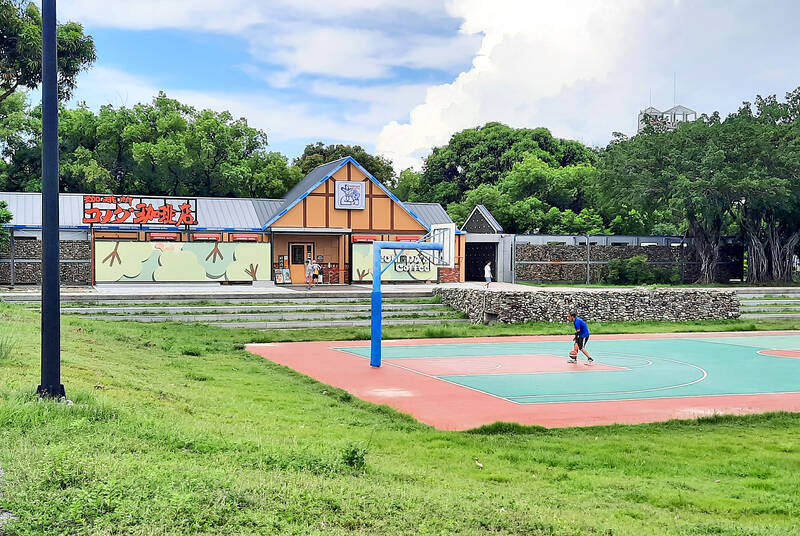
Photo: Steven Crook
At the time of Morakot, the city had just one flood detention pond, a 110,000-cubic-meter basin in Sanmin District (三民). Kaohsiung now has 25 such ponds, 10 of which were completed in the last six years. In some cases, the authorities had to overcome opposition from residents who feared that having a detention basin nearby might increase the risk of their homes being flooded.
The Tainan section of Southern Taiwan Science Park (南部科學園區) came through Gaemi unscathed, but that was no consolation for some of those living nearby. While the park administration hailed the success of the industrial zone’s flood detention system, the borough warden of Shyjhongrong (許中營) told the China Times (July 26) that the high foundations of the park’s semiconductor fabs and optoelectronics factories had turned his own low-lying community into another detention pond.
MAJOR INVESTMENTS
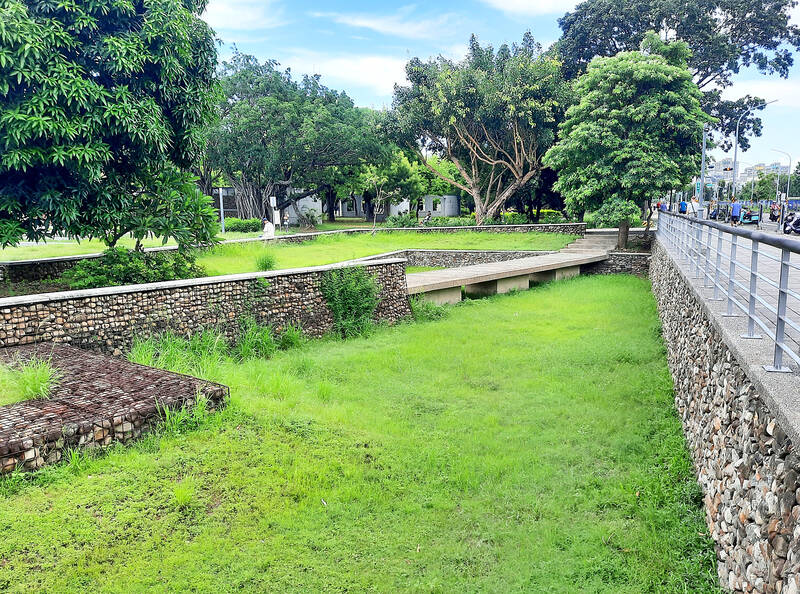
Photo: Steven Crook
Kaohsiung’s flood detention ponds vary greatly in land area and capacity, with three of the largest being close to Dianbao Creek (典寶溪) in Ciaotou (橋頭) and Gangshan (岡山) districts. Together, they can hold up to 4.98 million cubic meters of water, greatly reducing the pressure on the city’s drains and waterways.
Such facilities also serve as parks and ameliorate urban heat, but they don’t come cheap. To complete one of the Dianbao Creek projects, the authorities spent NT$1.7 billion on acquiring land and a further NT$134.56 million on construction.
The UDN article quoted Yu Pao-shan (游保杉), an emeritus professor in National Cheng Kung University’s Department of Hydraulic and Ocean Engineering, as saying that Kaohsiung’s water-control infrastructure appears to have functioned as planned.
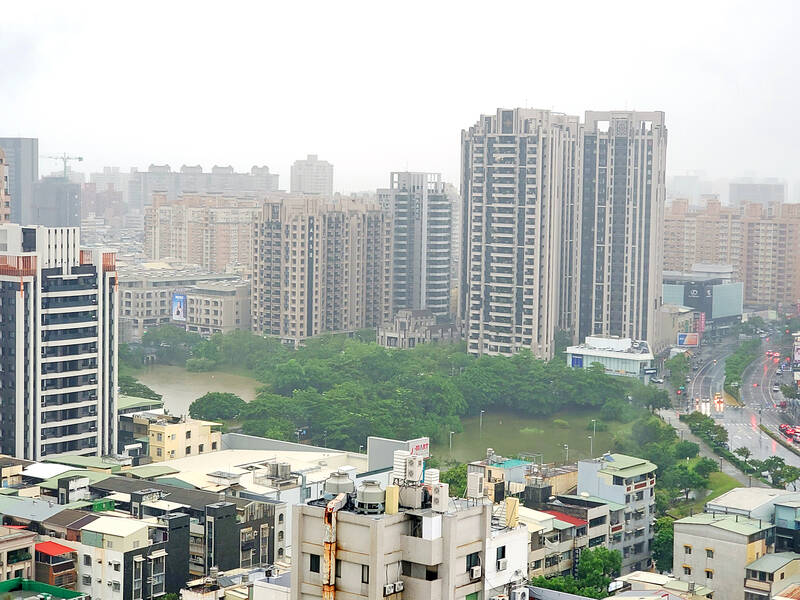
Photo: Chen Wen-chan, Liberty Times
Yu warned, however, that climate change may well cause even heavier rainfall in the future, and that this is an issue that Taiwan must face. Because precipitation is likely to exceed the current infrastructure’s design standards, he called on central and local governments, along with vulnerable communities, to jointly devise disaster-prevention strategies.
Like Yu, Liao Kuei-hsien (廖桂賢), director of the Taiwan Rivers Network, an NGO that works to promote the protection and restoration of river health, understands that Kaohsiung’s flood detention basins worked as intended. She responds to those who complain that the billions spent on them was wasted by saying that, even when precipitation is as extreme as during Gaemi, and even if future urban development increases overall flood risk, properly-maintained basins should still be able to hold back the amount of floodwater they were designed to detain.
“People need to understand that without human development, flooding is a natural phenomena,” says Liao, who’s also a professor in National Taipei University’s Graduate Institute of Urban Planning. When humans choose to develop an area that’s naturally flood-prone, rather than think flooding is abnormal, they should understand that artificial control, be it by flood detention basins or other hard infrastructure, is inevitably limited by its design standards, she says.

Photo: Lee Hui-chou, Taipei Times
Floating cars and submerged orchards make for compelling television, so it’s hardly surprising the media paid little attention to a village in Yunlin County that was spared the worst.
‘LOCALIZED FLOOD DETENTION’
Youcai (有才) in Baojhong Township (褒忠鄉) — a low-lying agricultural community susceptible to flooding — avoided serious problems during Gaemi as a result of what the Ministry of Economic Affairs’ Water Resources Agency calls “localized flood detention” (在地滯洪).
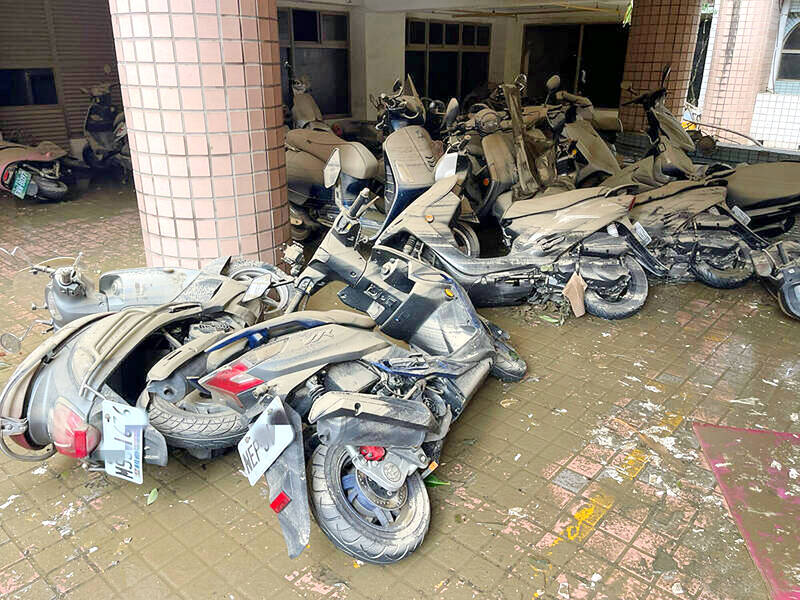
Photo: Taipei Times file
When sensors alerted the authorities to dangerously-high water levels, sluice gates were opened, releasing water onto farmland owned by Taiwan Sugar Corp (Taisugar). This second line of defense protected local homes from inundation. However, it’s an approach that requires more space than might be available in densely populated parts of Kaohsiung or Tainan.
Liao is among those who were impressed by the effectiveness of this solution, which creates detention capacity without extensively changing the landscape.
She says flood-prone cities and counties should create more space for water: “This includes, but shouldn’t be limited to, building more flood detention areas which aren’t conventional flood detention basins.”
Low-lying land should have more than one purpose, she argues. It can be farmland or parkland for most of the year, but ready to detain floodwater when needed.
“I think it’s especially important to incentivize farmers to allow their fallow fields to serve as flood detention areas during the typhoon season. Sufficient incentives could overcome the misconception that rainwater detention could ruin their farmland,” Liao says.
At the same time, Liao says Taiwan should embrace a different approach, one she has long championed. Rather than build even more flood-control infrastructure, she believes, the authorities should invest in making communities more floodable and flood-resilient, so that even if flooding occurs, there’s no significant damage or disruption.
Liao admits that this will be difficult, as Taiwan relies too much on hard infrastructure and people expect the government to invest in it.
“The entire system is designed around maintaining and adding flood control infrastructure,” she says, pointing out that such policies help politicians garner votes.
Liao doesn’t expect Typhoon Gaemi to lead to a change in thinking.
“It wasn’t ‘serious enough,’ in that it was mostly rural people who really suffered,” she says. “I think it’d take Taipei City being under deep water before mindsets change.”
Steven Crook, the author or co-author of four books about Taiwan, has been following environmental issues since he arrived in the country in 1991. He drives a hybrid and carries his own chopsticks. The views expressed here are his own.
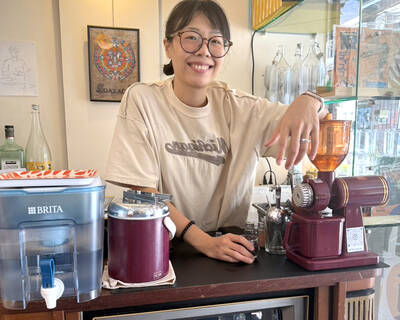
Cheng Ching-hsiang (鄭青祥) turned a small triangle of concrete jammed between two old shops into a cool little bar called 9dimension. In front of the shop, a steampunk-like structure was welded by himself to serve as a booth where he prepares cocktails. “Yancheng used to be just old people,” he says, “but now young people are coming and creating the New Yancheng.” Around the corner, Yu Hsiu-jao (饒毓琇), opened Tiny Cafe. True to its name, it is the size of a cupboard and serves cold-brewed coffee. “Small shops are so special and have personality,” she says, “people come to Yancheng to find such treasures.” She

In July of 1995, a group of local DJs began posting an event flyer around Taipei. It was cheaply photocopied and nearly all in English, with a hand-drawn map on the back and, on the front, a big red hand print alongside one prominent line of text, “Finally… THE PARTY.” The map led to a remote floodplain in Taipei County (now New Taipei City) just across the Tamsui River from Taipei. The organizers got permission from no one. They just drove up in a blue Taiwanese pickup truck, set up a generator, two speakers, two turntables and a mixer. They

Former Chinese Nationalist Party (KMT) chairwoman Hung Hsiu-chu’s (洪秀柱) attendance at the Chinese Communist Party’s (CPP) “Chinese People’s War of Resistance Against Japanese Aggression and the World Anti-Fascist War” parade in Beijing is infuriating, embarrassing and insulting to nearly everyone in Taiwan, and Taiwan’s friends and allies. She is also ripping off bandages and pouring salt into old wounds. In the process she managed to tie both the KMT and the Democratic Progressive Party (DPP) into uncomfortable knots. The KMT continues to honor their heroic fighters, who defended China against the invading Japanese Empire, which inflicted unimaginable horrors on the

Hannah Liao (廖宸萱) recalls the harassment she experienced on dating apps, an experience that left her frightened and disgusted. “I’ve tried some voice-based dating apps,” the 30-year-old says. “Right away, some guys would say things like, ‘Wanna talk dirty?’ or ‘Wanna suck my d**k?’” she says. Liao’s story is not unique. Ministry of Health and Welfare statistics show a more than 50 percent rise in sexual assault cases related to online encounters over the past five years. In 2023 alone, women comprised 7,698 of the 9,413 reported victims. Faced with a dating landscape that can feel more predatory than promising, many in